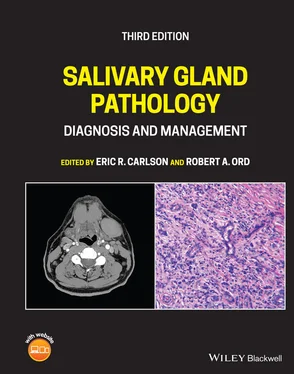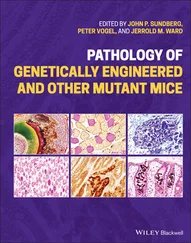1 ...6 7 8 10 11 12 ...47 From the perspective of 50+ years of navigation in the ablative and reconstructive precincts of oral and maxillofacial surgery, one can safely relate today’s circumstances to those of “back when”. In the earlier decades of the last half‐century, imaging diagnosis of salivary gland disease depended chiefly on plain radiography and contrast sialography; microscopic diagnosis was dependent on the accommodation of a tumor to one of perhaps a dozen epithelial variants; chemotherapy protocols were essentially adaptions of those used for management of squamous cell carcinoma; salivary carcinoma was thought impervious to radiation therapy; surgical management of salivary malignancy fell almost exclusively to those few otolaryngologists, general surgeons, or, more infrequently, oral and maxillofacial surgeons, with special interests in treating these relatively uncommon lesions.
Immense progress in understanding the pathophysiology of salivary gland disease in later years has delivered incredibly complicated microscopic classifications and more precisely directed chemical treatment protocols, and over the past two decades, the earlier assumption that salivary gland disease was impervious to radiation therapy has been demolished. This improved understanding of salivary gland biology has brought in train the need for increasingly well‐founded and sophisticated care within all interested surgical groups; Dr. Carlson in Knoxville, and Dr. Ord in Baltimore have answered this call with their surgical expertise and recognized educational efforts in oral and maxillofacial surgical training.
With this Third Edition, the authors have ensured their volume’s position in the lexicon of surgical texts, a metric against which all future efforts will be scaled.
Robert Bruce MacIntosh, DDS
Department of Oral and Maxillofacial Surgery, University of Detroit Mercy School of Dentistry, Detroit, MI, USA
The concept of this book devoted to the diagnosis and management of salivary gland pathology arose from our longstanding friendship and professional relationship where we first collaborated in the early 1990s. This led to a trip to India with the Health Volunteers Overseas in 1996, where we operated numerous complex cancer cases, including many salivary gland malignancies. Dr. Carlson's interest in benign and malignant tumor surgery was fostered by the expert surgical tutelage of Dr. Robert E. Marx at the University of Miami Miller School of Medicine/Jackson Memorial Hospital in Miami, Florida. It was the training by Professor John Langdon who nurtured Dr. Ord's love of the parotidectomy. Over the years, following the publication of several papers and book chapters devoted to salivary gland surgery, we realized that a textbook and atlas related to this discipline should be produced. It was believed that a work written by two surgeons who shared similar surgical philosophies would be a unique addition to the current literature. This has been a project that we have approached with energy and enthusiasm which hopefully is evident to the reader.
The diagnosis and management of salivary gland pathology are an exciting and thought provoking discipline in medicine, dentistry, and surgery. It is incumbent on the clinician examining a patient with a suspected developmental, neoplastic, or non‐neoplastic lesion of the major or minor salivary glands to obtain a comprehensive history and physical examination, after which time a differential diagnosis is established. A definitive diagnosis is provided with either an excisional or incisional biopsy depending on the gland involved and the differential diagnosis established preoperatively. A complete understanding of the anatomic barriers surrounding a salivary gland lesion is paramount when performing surgery for a salivary gland neoplasm.
It is the purpose of this Textbook and Color Atlas of Salivary Gland Pathology to provide both text and clinical images, thereby making this a singular work. The reader interested in the science and evidence based medicine associated with the management of salivary gland pathology will be attracted to our text. The reader interested in how to perform salivary gland surgery as a function of diagnosis and anatomic site will find the real‐time images useful. To that end, artist sketches are limited in this book. Where appropriate, algorithms have been included as a guide for diagnosis and management. It is our hope that this text and atlas will find a home on the bookshelves of those surgeons who share our fascination with the diagnosis and management of salivary gland disease.
Eric R. Carlson, DMD, MD, FACS
Robert A. Ord, DDS, MD, FRCS, FACS, MS
In 2008, we published our first work entitled Textbook and Color Atlas of Salivary Gland Pathology – Diagnosis and Management. In preparation for the development and publication of the second edition of this book, several issues became apparent that resulted in changes and additions to our first edition. The first change is the title. We selected Salivary Gland Pathology – Diagnosis and Management due to the inherent and obvious textbook nature of this work. In addition, our readership is aware that our teaching mission involves the use of high quality color images to illustrate the cases included in each chapter and to guide the reader through the workup and execution of the medical and surgical management of salivary gland pathology. The title was shortened accordingly. All chapters have been updated in terms of references and the addition of new cases to illustrate important points within each chapter. This includes Chapter 7, Classification, Grading, and Staging of Salivary Gland Tumors , where histomicrographs of most of the benign and malignant salivary gland neoplasms are now illustrated in the chapter. In keeping with our expanding knowledge base of the diagnosis and management of salivary gland pathology, we have included four new chapters in this second edition, including those devoted to the molecular biology of benign and malignant salivary gland tumors, radiation therapy for salivary gland tumors, systemic therapy for salivary gland cancer, and pediatric salivary gland pathology. Four new authors have been added including Drs. Joseph Kelley, J. Michael McCoy, Janakiraman Subramanian, and Randy Todd. Where appropriate, algorithms have been included in the chapters to assist in decision making processes associated with the management of salivary gland pathology.
As with the first edition of this textbook, it is our expressed purpose to make this second edition a singular work with extensive text and clinical images. It is our hope that this textbook will provide a useful update to our international colleagues who benefited from the first edition.
Eric R. Carlson, DMD, MD, FACS
Robert A. Ord, DDS, MD, FRCS, FACS, MS, MBA
We enthusiastically present the third edition of Salivary Gland Pathology – Diagnosis and Management to practitioners and trainees, surgeons and pathologists, and clinicians and scientists alike. The World Health Organization's updated classification of head and neck tumors in 2017, including that of salivary gland tumors, is a reminder to the reader of the ephemeral nature of salivary gland pathology as well as the inherent need to frequently update our knowledge base. Therein, this third edition of our tome exploits the new information available regarding the taxonomy of salivary gland tumors as well as new neoplastic and non‐neoplastic entities, image guided biopsies of salivary gland lesions, minimally invasive surgery to address these entities, and the complications encountered in traditional and nontraditional forms of salivary gland surgery. To this end, we introduce two new chapters and five new authors. Professor Mark McGurk of the United Kingdom requires no introduction as his contributions to oral and maxillofacial surgery, and especially salivary gland surgery, are extensive, innovative, highly meaningful, and transformational. Dr. Katherine George teamed up with Professor McGurk to review their experiences with innovative salivary gland surgery, including diagnostic and therapeutic sialendoscopy. Dr. Michael Turner of New York City is also an accomplished salivary gland surgeon and lends his expertise in the management of complications to our textbook. Dr. Laura Kujtan joins Dr. Subramanian in their update of chemotherapy and targeted therapy for salivary gland malignancies. Finally, Dr. Ofori collaborated with Dr. Joseph Kelley in their scholarly review of radiation therapy in the management of salivary gland tumors.
Читать дальше












